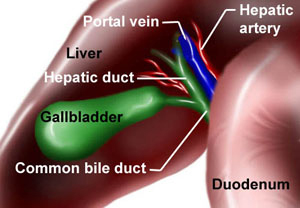Biliary disease and pathology related to the hepatobilliary tract are common GI entities that you will see in the emergency department. Nearly 20 million Americans are suspected to carry gallstones; most of these are silent. Over the age of 40, about 8% of men and 20% of women will develop gallstones. Fortunately, only 10% of these gallstones will need surgical intervention or become symptomatic over the course of a lifetime.
Focused ultrasound sensitivity for the detection of gallstones is about 86% in the hands of a trained emergency physician sonographer. Specificity is 97%. Negative predictive value (meaning if it's a negative scan, you can hang your hat that it IS negative- like a d-dimer) is 92%.
Sensitivity and specificity for detection of cholelithiasis is 91% and 97% respectively.
Normal Anatomy

Cholecystitis
Cholecystitis is an acute inflammation of the gallbladder which may be calculous (with gallstones) or acalculous (without -5%). Historical features include colicky abdominal pain associated with fever, tachycardia, RUQ or epigastric tenderness, usually after consuming a fatty meal. Early cholecystitis presents in a visceral pain fashion (i.e. dull and difficult to localize). As the common bile duct (CBD) is progressively distended from blockage, pain becomes more localizable.
Acalculous cholecystitis is frequently seen in post-partum or post-op patients, patients with major trauma or burns, patients with vasculopathy, in diabetics, and in those who carry diagnoses of CHF or sepsis. The elderly are at an increased risk of developing the disease. Gangrene of the gallbladder and perforation are more common than in calculous cholecystitis.
Emphysemataous cholecystitis (very grave) occurs when gas forming organisms (E coli, clostridium, klebsiella, or anaerobic strep) inhabit the gallbladder.
Gallstone ileus, an uncommon variant of hepatobiliary disease, occurs when a large gallstone erodes into the duodenum, travels to the distal ileum and produces obstruction. It is usually seen in elderly women with a preexisting history of gallstones. Pneumobilia may accompany the diagnosis.